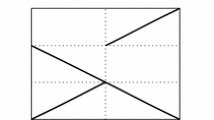Abstract
It is known that the “pattern containment” order on permutations is not a partial well-order. Nevertheless, many naturally defined subsets of permutations are partially well-ordered, in which case they have a strong finite basis property. Several classes are proved to be partially well-ordered under pattern containment. Conversely, a number of new antichains are exhibited that give some insight as to where the boundary between partially well-ordered and not partially well-ordered classes lies.
Similar content being viewed by others
References
Atkinson, M. D. (1999) Restricted permutations, Discrete Math. 195, 27–38.
Atkinson, M. D. and Stitt, T. Restricted permutations and the wreath product, In preparation.
Atkinson, M. D. (1998) Permutations which are the union of an increasing and a decreasing sequence, Electron. J. Combin. 5, Paper R6.
Atkinson, M. D. (1998) Generalised stack permutations, Combinatorics, Probability and Computing 7, 239–246.
Atkinson, M. D. and Beals, R. Finiteness conditions on closed classes of permutations, unpublished.
Bose, P., Buss, J. F. and Lubiw, A. (1998) Pattern matching for permutations, Inform. Process. Lett. 65, 277–283.
Cohen, D. I. A. (1978) Basic Techniques of Combinatorial Theory, Wiley, New York.
Higman, G. (1952) Ordering by divisibility in abstract algebras, Proc. London Math. Soc. 2, 326–336.
Knuth, D. E. (1967) Fundamental Algorithms, The Art of Computer Programming, Vol. 1, 1st edn, Addison-Wesley, Reading, Mass.
Lakshmibai, V. and Sandhya, B. (1990) Criterion for smoothness of Schubert varieties, Proc. Indian Acad. Sci. Math. Sci. 100, 45–52.
Murphy, M. M., Ph.D. Thesis, University of St Andrews, in preparation.
Shapiro, L. and Stephens, A. B. (1991) Bootstrap percolation, the Schöder number, and the N-kings problem, SIAM J. Discrete Math. 2, 275–280.
Pratt, V. R. (1973) Computing permutations with double-ended queues, parallel stacks and parallel queues, Proc. ACM Symp. Theory of Computing 5, 268–277.
Simion, R. and Schmidt, F. W. (1985) Restricted permutations, European J. Combin. 6, 383–406.
Spielman, D. A. and Bóna, M. (2000) An infinite antichain of permutations, Note N2, Electron. J. Combin. 7(1).
Stankova, Z. E. (1994) Forbidden subsequences, Discrete Math. 132, 291–316.
Stankova, Z. E. (1996) Classification of forbidden subsequences of length 4, European J. Combin. 17(5), 501–517.
Tarjan, R. E. (1972) Sorting using networks of queues and stacks, J. ACM 19, 341–346.
West, J. (1996) Generating trees and forbidden sequences, Discrete Math. 157, 363–374.
Author information
Authors and Affiliations
Rights and permissions
About this article
Cite this article
Atkinson, M.D., Murphy, M.M. & Ruškuc, N. Partially Well-Ordered Closed Sets of Permutations. Order 19, 101–113 (2002). https://doi.org/10.1023/A:1016500300436
Issue Date:
DOI: https://doi.org/10.1023/A:1016500300436



